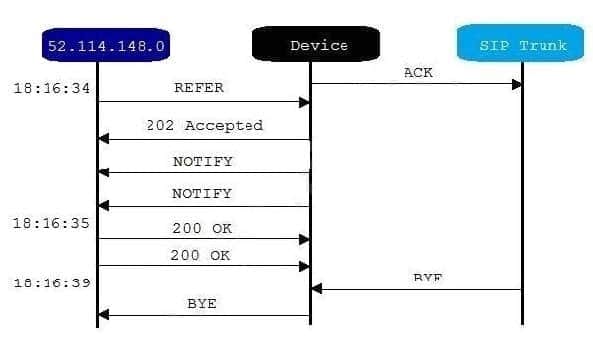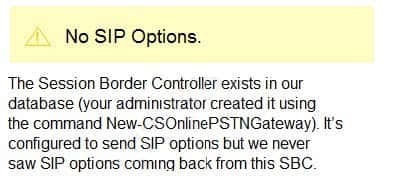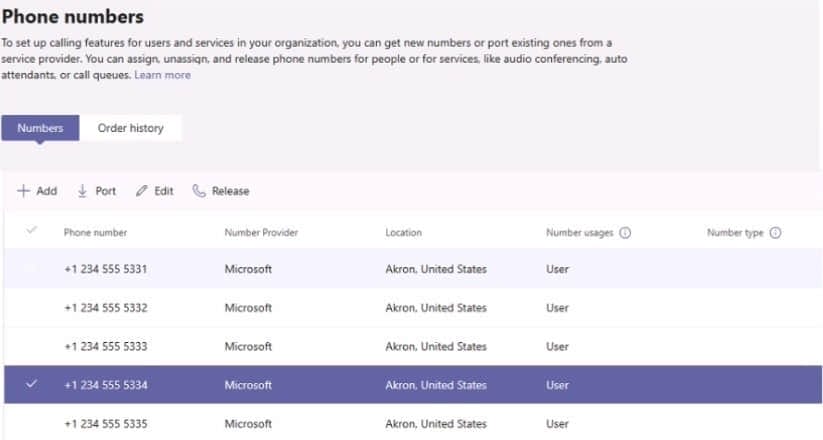MS-720 Online Practice Questions and Answers
Your company has a Microsoft Teams Phone deployment that uses Direct Routing and a single carrier.
You deploy a new Session Border Controller (SBC) that shows as healthy in the Microsoft Teams admin center.
You place a test call over the new SBC, and the call succeeds.
When you attempt to transfer the call, the transfer fails. A portion of the SIP ladder is shown in the exhibit. (Click the Exhibit tab.)

What is a possible cause of the issue?
A. The SSL certificate of the SBC is incorrect.
B. The Refer on the SBC is misconfigured.
C. notify is enabled in the SIP options of the SBC.
D. The carrier rejects the format of the forwarded FROM number.
You have a Microsoft I earns deployment and an existing telephony solution that provides PSTN capability to on premises third-party PBX systems in two separate locations.
You need to implement a redundant PSTN solution for Microsoft Teams Phone. The solution must use the existing telephony earner services. The solution must ensure that outbound calls can be made if a component fails.
Which three components should you implement? Each correct answer presents part of the solution.
NOTE: Each correct selection is worth one point
A. highly available Session Border Controllers (SBCs)
B. calling policies
C. PSTN usages
D. voice routing policies
E. tenant dial plans
Your company uses configuration profiles to manage Microsoft Teams-certified IP phones. The Standard configuration profile is applied to the IP phones.
The help desk receives reports that several user phones fail to lock automatically after the timeout period.
You need to verify whether the configuration profile is applied to the problematic phones.
Solution: From Devices in the Microsoft Teams admin center, you locate each affected phone and review the settings on the Details tab.
Does this meet the goal?
A. Yes
B. No
You are planning a Microsoft Teams Phone deployment that will use Direct Routing. You need to allow traffic from Microsoft 365 to a Session Border Controller (SBC). Which IP address ranges should you allow through the firewall?
A. 132.245.0.0/16 and 40.104.0.0/15
B. 10.10.0.0/24 and 10.11.0.0/24
C. 8.8.8.8/32 and 4.4.2.2/32
D. 52.112.0.0/14 and 52.120.0.0/14
Your company assigns an Office 365 E3 license to each user. All users are in France.
You plan to deploy Direct Routing.
Which additional license should you assign to the users?
A. Microsoft 36S Domestic and International Calling Plan
B. Microsoft Teams Phone Standard - Virtual User
C. Microsoft 36S Domestic Calling Plan
D. Microsoft 365 Audio Conferencing
E. Microsoft Teams Phone Standard
Note: This question is part of a series of questions that present the same scenario.
Each question in the series contains a unique solution that might meet the stated goals. Some question sets might have more than one correct solution, while others might not have a correct solution.
After you answer a question in this section, you will NOT be able to return to it. As a result, these questions will not appear in the review screen.
You need to create a new call queue to route calls to support agents. The support agents must be able to see their call queue history and the shared transcribed voicemail. The solution must minimize administrative effort.
Solution: You configure the call queue to use a team and a channel.
Does this meet the goal?
A. Yes
B. No
You have a Microsoft Teams Phone deployment.
You are deploying Direct Routing.
All users have a SIP URI in the format of [email protected]. The Session Border Controller (SBC) is named sbc.voice.contoso.com.
When troubleshooting errors on the SBC, you receive the warning shown in the following exhibit.

What is a possible cause of the issue?
A. The firewall blocks outbound traffic on port 443 to Microsoft Teams.
B. The firewall blocks traffic to the signaling port on the SBC.
C. TLS 1.2 is enabled on the SBC.
D. Microsoft 365 Phone System licenses are not assigned to the users.
The sales department at your company needs to route a call to multiple users and have calls route differently after business hours.
Which two features should you implement? Each correct answer presents part of the solution. NOTE: Each correct selection is worth one point.
A. auto attendants
B. caller ID policies
C. calling policies
D. call queues
E. voice routing policies
You have a Microsoft Teams Phone deployment
You assign a Microsoft 365 E5 license lo a user named User1.
You need to enable User1 for Direct Routing.
Which PowerShell cmdlet should you run?
A. Set-CsCallingLineIdentity
B. Set-CsUser
C. Set-CsOnlineVoiceUser
D. Set-CsUserServicesPolicy
You are deploying Microsoft Teams Calling Plans.
You port all phone numbers to Microsoft Teams Phone as shown in the exhibit (Click the Exhibit tab.)

You need to assign. The number -1-234-555-5334 to an auto attendant. What should you do first?
A. Get an auto attendant toll number.
B. Assign the number to the resource account of the auto attendant.
C. Open a Microsoft support case to initiate an inventory type change.
D. Create a port order for a user number.